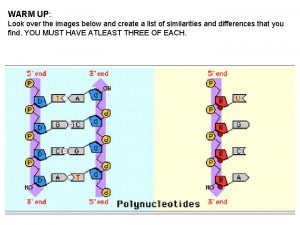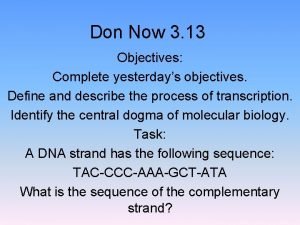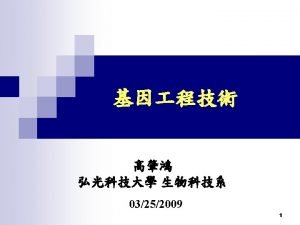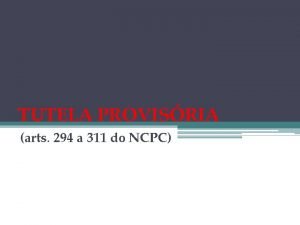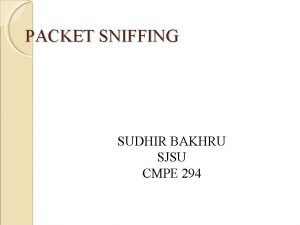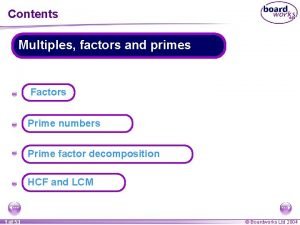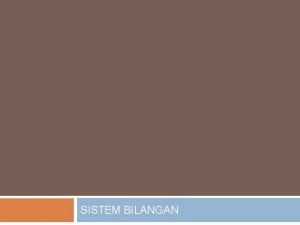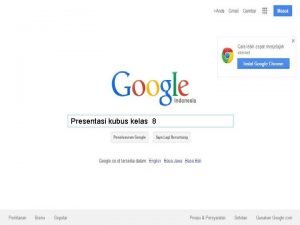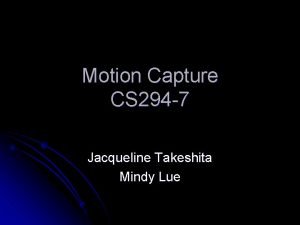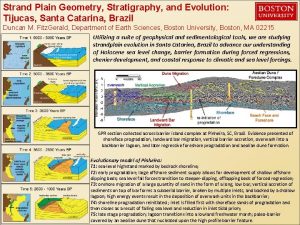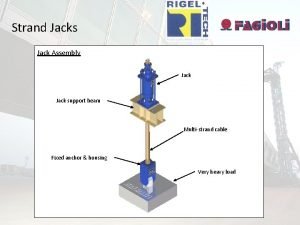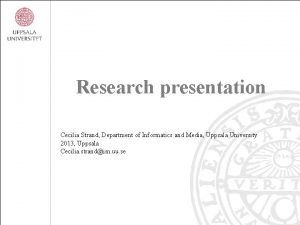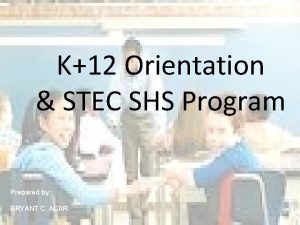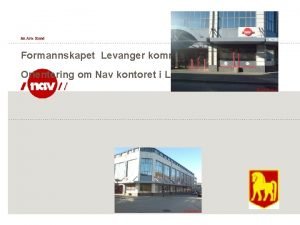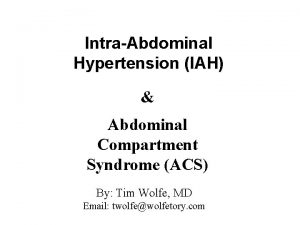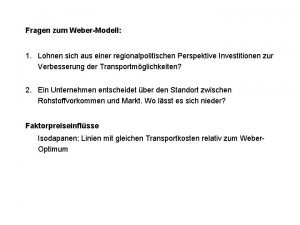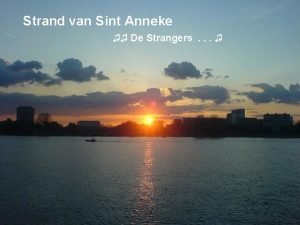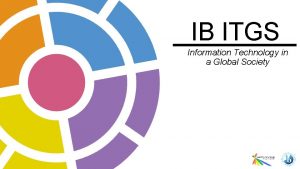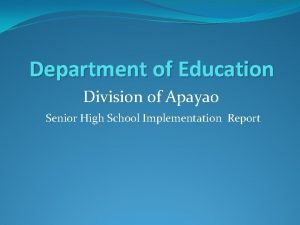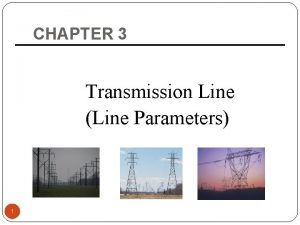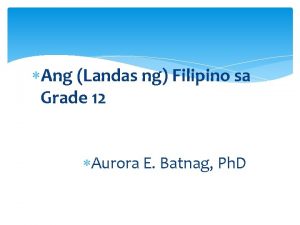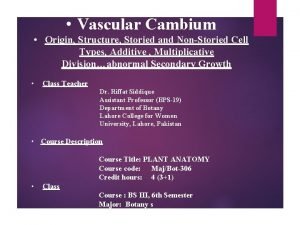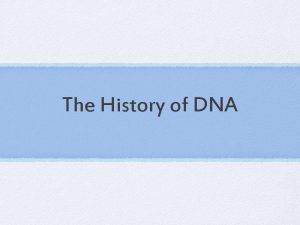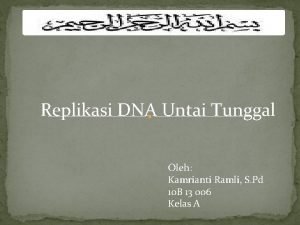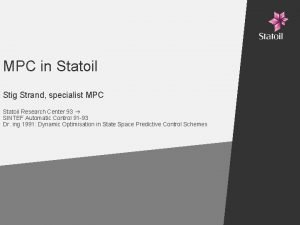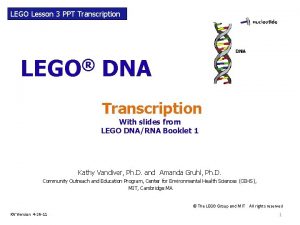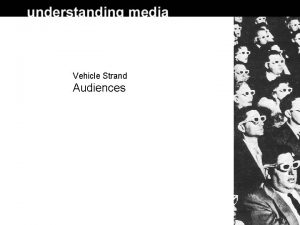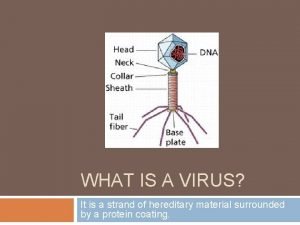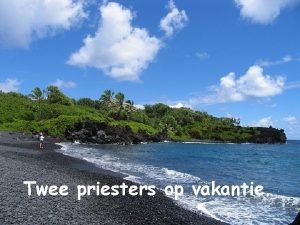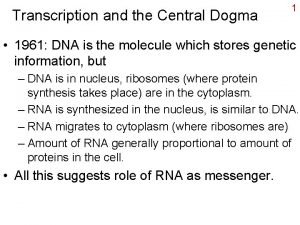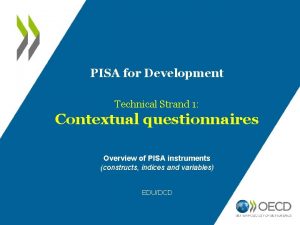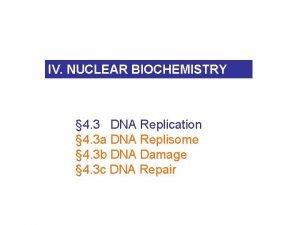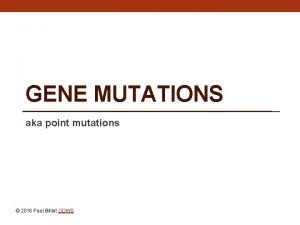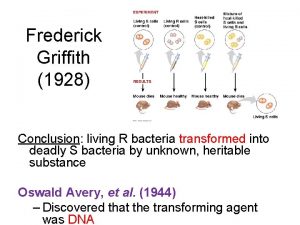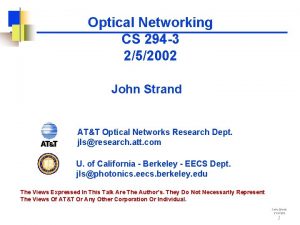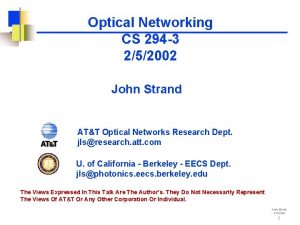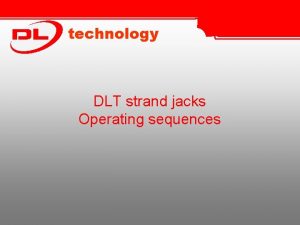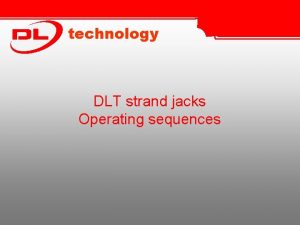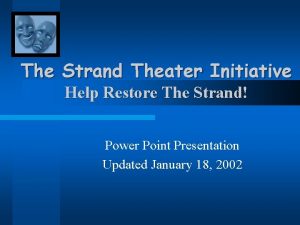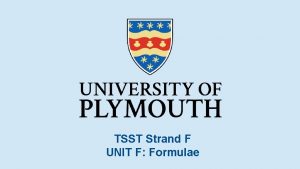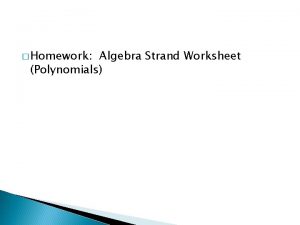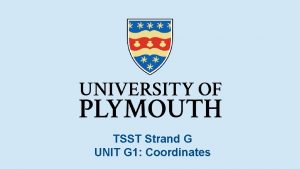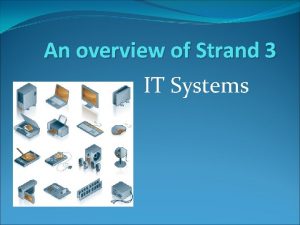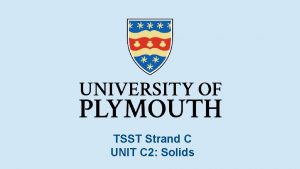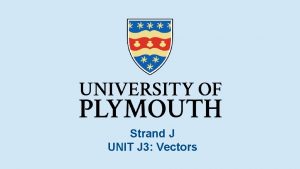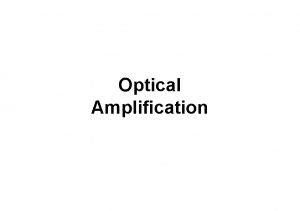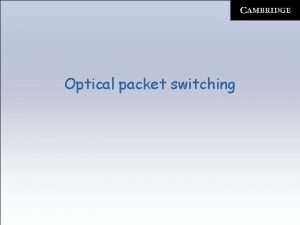Optical Networking CS 294 3 252002 John Strand













































































- Slides: 77

Optical Networking CS 294 -3 2/5/2002 John Strand AT&T Optical Networks Research Dept. jls@research. att. com U. of California - Berkeley - EECS Dept. jls@photonics. eecs. berkeley. edu The Views Expressed In This Talk Are The Author’s. They Do Not Necessarily Represent The Views Of AT&T Or Any Other Corporation Or Individual. John Strand 1/18/2002 1

Outline • Transport - Traditional TDM Networks • Optical Networking & IP Concentrate On Intercity Networks • Time Constraint • Metro, Access Optical Networks More Complex, Less Mature John Strand 1/18/2002 2

Layering Possible Service Architecture Layers IP Layers Prototype Apps Context Awareness Services Adaptation Services Wide-Area Services PM & Monitoring Application Transport Layers "Service" DS 1 DS 3 Tranport Network SONET- Path Line Section Link Wavelength Fiber Physical Cable Conduit ROW John Strand 1/18/2002 3

Basic DS-1 Signal Format 193 Bits F Bit Time Slot 1 Time Slot 2 1 bit 8 bits Time Slot 3 8 bits o o o Time Slot 23 8 bits Time Slot 24 8 bits • Designed To Carry 24 Full Duplex 64 Kilobit/sec Voice Circuits (“DS-0’s”) • Transmission Rate = 1. 55 Megabits/Second (8000 frames/sec * 193 bits/frame) • DS-1 Is A Protocol; T-1 Is A Specific AT&T Implementation Of This Protocol For Local Networks • This Is The Traditional Building Block For Transmission Networks In U. S. John Strand 1/18/2002 4

What is SONET? • Synchronous Optical Network standard SONET Interface Digital Tributaries • • • SONET Network Element Digital Tributaries Defines a digital hierarchy of synchronous signals Maps asynchronous signals (DS 1, DS 3) to synchronous format Defines electrical and optical connections between equipment Allows for interconnection of different vendors’ equipment Provides overhead channels for interoffice Operations, Administration, Maintenance, & Provisioning (OAM&P) John Strand 1/18/2002 5

SONET Structure PRS: Primary Source ST 2: Stratum 2 ST 3: Stratum 3 Network Of Synchronized Clocks Must Be Synchronized Byte-Interleaved Multiplexing John Strand 1/18/2002 6

Digital Signal Hierarchies Most Common Rates DS-1 (1. 544 Mb/s) 1 DS-3 28 VT 1. 5 STS-1 (1. 7 Mb/s) (52 Mb/s) VC-11 VC-3 Asynchronous ("Plesiochronous") [Non-Standardized] (45 Mb/s) 84 336 1344 5376 Capacity (DS-1 Equiv) STS-3 STS-12 STS-48 STS-192 (156 Mb/s) (622 Mb/s) (2500 Mb/s) (10000 Mb/s) SONET STM-1 STM-4 STM-16 STM-64 SDH DS: Digital Signal SONET: Synchronous Optical NETwork (US) SDH: Synchronous Digital Hierarchy (ITU) STS: Synchronous Transport Signal STM: Synchronous Transfer Mode VC: Virtual Container VT: Virtual Tributary John Strand 1/18/2002 7

SONET Rates Level Optical Designation Bit Rate (Mb/s) STS-1 OC-1 51. 840 STS-3 OC-3 155. 520 STS-12 OC-12 622. 080 STS-48 OC-48 2, 488. 320 STS-192 OC-192 9, 953. 280 STS-768 OC-768 39, 813. 120 STS OC = SYNCHRONOUS TRANSPORT SIGNAL = OPTICAL CARRIER (“. . result of a direct optical converions of the STS after synchronous scrambling” - ANSI) EC (Not Shown) = ELECTRICAL CARRIER John Strand 1/18/2002 8

SONET STS-1 Frame Structure 3 Bytes 87 Bytes t 87 Columns Ptr t T O H 3 Bytes P O H Synchronous Payload Envelope (SPE) 9 Rows P O H F I x e d S t u f f SPE F I x e d S t u f f 87 Bytes John Strand 1/18/2002 9

STS-N And STS-Nc (N = 3, 12, 48, 192) • STS-N • Formed By Byte-Interleaving N STS-1 Signals • 3 N Columns of Transport Overhead • Frame Aligned • Redundant Fields Not Used - eg APS, Datacomm • N Distinct Payloads (87 N Bytes) • NOT Frame Aligned • N Columns Of Path Overhead - All Used • 2 N Columns Of Fixed Stuff Bytes • 84 N Columns Of Information • STS-Nc • 3 N Columns of Transport Overhead • Frame Aligned • Redundant Fields Not Used - eg APS, Datacomm • Single Payload • 1 Column Of Path Overhead • 3 N - 1 Columns Of Fixed Stuff Bytes • 87 N - N/3 Columns Of Information John Strand 1/18/2002 10

SONET/SDH Layering Multiplexer Or Other PTE Cross. Connect Regenerator (derived clock) Cross. Connect Multiplexer Or Other PTE SONET Path SDH Virtual Container (VC) Line Multiplex Section (MS) Section Regenerator Section (RS) Key Feature: Basis Of • Fault Management & Restoration • Maintenance John Strand 1/18/2002 11

Service Survivability Objectives Typical Commercial Networks Restoration Time Objectives (secs) 1000 10 1 0. 01 Standard Leased Frame Voice Lines Relay IP Services New trends in IP services: supporting real-time application, e. g. voice and video, & mission critical data => Require much faster restoration than traditional IP rerouting John Strand 1/18/2002 12

Network Outage Analysis Voice Services Equipment Failure Route Failure • Backhoe, Flood, Train Wreck • ~1/1000 km/year John Strand 1/18/2002 13

Survivability 101 C X A D B Y Protection: Pre-Allocated Survivability Requires: Restoration: Dynamically Allocated • Fault Detection • Spare Inter-Office Capacity • Switch Fabrics To Put Failed Facility On This Capacity • Control Logic To Identify Fault & Reroute Failed Circuits John Strand 1/18/2002 14

Effect Of Restoration Topology Restoration Overbuild (Protection Capacity/Service Capacity) "Ring" Degree 2 Nodes Degree 3 Nodes 100% 50% "Mesh" Degree N Nodes 1/(N-1) Degree = # Of Physically Diverse Routes John Strand 1/18/2002 15

Ring Example SONET: Bi-Directional Line-Switched Ring (BLSR) SDH: Multiplex Section Shared Protection Ring (MS-SPRING) S S: Service P: Protection B S C P P S P Different Fibers But Same Cable A D P P S S P F E S Original Circuit Protection Switch John Strand 1/18/2002 16

Ring Example SONET: Bi-Directional Line-Switched Ring (BLSR) SDH: Multiplex Section Shared Protection Ring (MS-SPRING) S S: Service P: Protection B S C P P S P Different Fibers But Same Cable A Standardization: • Physical Layer & Signaling Standardized • Client State Information Not Standardized • OAM Not Standardized D P P S X S P F S E Original Circuit Protection Switch John Strand 1/18/2002 17

Public Switched Telephone Network (PSTN) Central Office Toll Network Central Office CO Customer Premises Equipment (CPE) CO Toll Connect Trunks Inter-Toll Trunks 64 Kb/sec FDX Circuits Switches: Terminate Trunks Switch Individual Calls John Strand 1/18/2002 18

Basic Service Types Central Office CPE PSTN "POTS" PBX Switch • ~ 100 Intercity Switches* Transport Network Private Line (PL) • Shared By Many Services • ~10 x As Many Offices* POTS: Plain Old Telephone Service * ATT Network John Strand 1/18/2002 19

Entering The Transport Network 64 kb/s POTS & VG PL 1 O O 24 O O 1. 5 Mb/s D S 1 45 - 622 Mb/s 1 o D S 3 o o 1. 5 Mb/s PL 45 - 2500 Mb/s PL 1 Gb Ethernet 2. 5 - 10 Gb/s o 28 O C 192 W D M Backbone Fiber Network 1 - 10 Gb/s PL, 10 Gb WAN Ethernet * 10 Gb WAN Ethernet • SONET Framed - 9. 953 Gb/s • Asynchronous POTS: "Plain Old Telephone Service" VG: Voice Grade PL: Private Line John Strand 1/18/2002 20

Service Routing Service Layer (e. g. , POTS or PL) Transport Layer John Strand 1/18/2002 21

Outline • Transport - Traditional TDM Networks • Optical Networking & IP John Strand 1/18/2002 22

Fiber Structure Pure Glass Core Lightpack Cable Design 8. 3 micron* Glass Cladding Protects “core” Serves as a “Light guide” 125 micron Inner Polymer Coating Outer Polymer Coating Protection Layers 250 micron Single Fiber Typical Loss: 0. 2 – 0. 25 d. B/km Plus Connector Loss * Single Mode Fiber; Multi-Mode Has A 50 Micron Core John Strand 1/18/2002 23

Intercity Fiber Network About 50, 00 Route Miles Of Fiber Cable John Strand 1/18/2002 24

Optical Amplifier/WDM Revolution Frequency-registered transmitters l 1 Receivers R All-Optical Amplification Of Multi-Wavelength Signal!!! R l 2 l 3 WDM Mux OA OA WDM De. Mux R 40 - 120 km (80 km typically) l. N Up to 10, 000 km (600 km in 2001 basic commercial products) WDM: Wavelength Division Multiplex OA: Optical Amplifier R John Strand 1/18/2002 25

John Strand 1/18/2002 A. Willner 26

Optical Amplifier/WDM Revolution Conventional Transmission - 20 Gb/s 40 km 40 km 40 km 1310 1310 LTE RPTR RPTR 1310 1310 LTE LTE 1310 1310 1310 1310 RPTR RPTR RPTR RPTR LTE DS 3 LTE 1310 1310 1310 1310 RPTR RPTR RPTR RPTR LTE LTE RPTR RPTR RPTR RPTR 1310 1310 1310 1310 LTE DS 3 LTE RPTR RPTR RPTR RPTR RPTR RPTR RPTR RPTR 1310 1310 1310 1310 1310 1310 1310 1310 LTE LTE RPTR RPTR OC-48 DS 3 120 km OC-48 OC 3/12 OC-48 OC-48 DS 3 OC-48 OC 3/12 OC-48 OA 12 fibers OA 1 fiber; 36 regenerators 1 optical amplifier In Each Direction: • 12 Is. Fibers Economic Advantage Distance Dependent • Intercity: Compelling • 36 Regenerators • Metro: WDM: Wavelength Division Multiplex OA: Optical Amplifier Depends On Dark Fiber Availability John Strand 1/18/2002 27

Single Fiber Capacity Moore's Law Bandwidth Capacity = (Bandwidth/ l) * (Bits / l) Source: K. Coffman & A. Odlyzko, “Internet Growth: Is There A Moore’s Law For Data Traffic? ” (research. att. com/~amo) John Strand 1/18/2002 28

Single Fiber Capacity Bandwidth S++ S+ Fiber loss 1300 1400 S C L 1525 1565 1600 John Strand 1/18/2002 29

Single Fiber Capacity Bandwidth/l - C Band 4 THz ¦(THz) 199. 0 196. 0 195. 0 194. 0 193. 0 192. 0 l (nm) 1505 1510 ~ 125 GHz/nm 50 GHz Spacing (For OC 48) 100 GHz Spacing (For OC 192) 1530 1535 1540 1545 1550 1555 1560 1565 C-Band (80 l) x (2. 5 GHz/l) = 200 GHz x 2 (40 l) x (10 GHz/l) = 400 GHz John Strand 1/18/2002 30

Transport Layer Model “Packet” 1/0 DCS Core ATM/IP Layers DACS III LA DS 3 (45 Mb/s) OC 48+ (2. 5+ Gb/s) Hard. Wired LA OTS 3/1 DCS ADM OTS OTS PHNX CHCG 3/1 DCS Layer 3/3 DCS Layer (DACS III) SONET ADM Layer CHCG Wavelength Path Crossconnect OTS (OTS: Optical Transport CHCG System) CHCG PHNX 3/1 DCS ADM Proprietary (20 -400 Gb/s) LA Service Layers CHCG ADM ADM 3/1 DCS LA 3/1 DCS DACS III ADM 4 E 4 E CHCG DS 1 (1. 5 Mb/s) DACS III PHNX ADM 4 E LA 1/0 DCS DS 3 (45 Mb/s) ATM/IP LA 4 E 1/0 DCS ATM/IP 1/0 DCS “Packet” Fiber Conduit/ Sheath Wavelength Mux Section Crossconnect Media Layer John Strand 1/18/2002 31

Optical Cross-Connect (OXC) Alternatives Line Rate (Proprietary) OC 48 OC 192 D W D M Wavelength Multiplex Section (WMS) Cross. Connect ADM’s D W D M Wavelength Path Cross. Connect SDCS Other Service Equipment D W D M • More Bits Per Port • Multivendor & Restoration Issues WIXC Would Go Here • Fewer Bits Per Port • Compatible With Opaque Architecture • Better For Restoration Could Have Either Optical Or Electrical Fabric John Strand 1/18/2002 32

Office Architecture Impact Optical Cross-Connect (Wavelength Path Cross-Connect) Service Layers OXC • Adds An Additional Cost • Operationally Essential In Larger Offices & Offices With High Churn • Allows Software Controlled Provisioning John Strand 1/18/2002 33

Opaque Wavelength Path Crossconnect Optical transport system (1. 55 mm) Standard cross-office optics (1. 3 mm) Optical transport system (1. 55 mm) = node-bypass . . . (Optical or Electronic Transparency Interior) Fibers Out . . . Wavelength Path Crossconnect . . . Add ports . . Fibers In . . l-Mux Drop ports John Strand 1/18/2002 34

Opaque Wavelength Path Crossconnect (Electrical Fabric) Power, Cooling Line Modules Optical Modules 640 Gbps, To 48 Tbps Processor Module Timing Module Transparent Switch Modules (STS-1 Granularity) Processor Module John Strand 1/18/2002 35

Fixed l Lasers in Optical Switches DWDM MUX D W D M D E M U X LR SR Rx Tx Rx LR Tx SR Rx Tx SR Rx LR Tx Rx Tx MUX DWDM Rx Tx Today’s switches are surrounded with OEO –> Fixed Wavelength 70% of system cost SR LR Rx Tx Fixed Wavelength M U X DWDM Fixed wavelength transponders are required for each input and output fiber John Strand 1/18/2002 36

An Early MEMS Device Free-Space Micromachined Optical Switch (FS-MOS) ers Switch Time < 1 ms tpu t fib 8 x 8 is 1 cm x 1 cm Ou Opportunities To Extend To Significantly Larger Arrays On A Single Substrate Measured Switching Times Under 1 ms (500 ms) 3 -D MEMS (2 degrees of Freedom) seems to be the Currently preferred architecture Micro lens Si substrate Free-rotating switch-mirror array Silicon substrate Input fibers Switch reconfigured by actuating selected micromirrors John Strand 1/18/2002 37

An 8 x 8 Switch Chip size: 1 cm x 1 cm Source: L-Y. Lin John Strand 1/18/2002 38

Contained Domain of Transparency TDRs Optical Domain Circuit Switch Issues: • Transmission Engineering Concerns Especially For Non-Tree Topologies • Fault Detection & Localization • Without Wavelength Conversion Becomes Separate Single-l Networks John Strand 1/18/2002 39

OTS System Length ADM o o o ADM D W D M Optical Transport System (OTS) 80 km OA 80 km OA OA OA 560 Km D W D M ADM o o o ADM “ 7 x 25 d. B Spacing” • Key Variables: • Distance Between OA's • Number of Spans John Strand 1/18/2002 40

Domains Of Transparency Transponder Costs In Traditional Systems John Strand 1/18/2002 41

Domains Of Transparency Ultra Long-Haul (ULH) Economics ~500 km A . . B C D Utilization (%) Transponder OA/OADM DWDM OTS Type Standard ULH/Standard 2 Cost Ratio 100 0 Ultra-Long Haul (ULH) 1. 75 1. 5 Standard Wins 1. 25 1 ~5000 km Typical ULH Technology Enhancements: • Strong Forward Error Correction • Raman Amplification • Dynamic Power Management ULH Wins 3 5 7 9 No. Of Standard OTS Systems (5 span) In Series • More Expensive Terminals & OA’s • Fewer Transponders At Intermediate Locations John Strand 1/18/2002 42

Contained Domain of Transparency TDRs Optical Domain Circuit Switch Issues: • Transmission Engineering Concerns Especially For Non-Tree Topologies • Fault Detection & Localization • Without Wavelength Conversion Becomes Separate Single-l Networks • Single-Vendor For The Forseeable Future John Strand 1/18/2002 43

Distance Before OEO Regen Limiting Factors Launch Power (PL) Nonlinearities PMD Constraint ~ (B * DPMD)-2 Operating Region Other System Parameters ASE Constraint ~ PL/SNRmin In Large All-Optical Domains • Each Vendor Trades Off The Design Parameters Differently • This Makes Routing In Multi-Vendor Networks Difficult To Standardize Length Of All-Optical Path Refs: A. Chiu, J. Strand, R. Tkach, "Issues for Routing In The Optical Layer", IEEE Communications (2001) J. Strand (ed. ), IETF I-D "Impairments And Other Constraints On Optical Layer Routing", draft-ietf-ipo-impairments-01. txt PL Launch Power SNRmin Min SNR PMD Polarization Mode Dispersion B Bandwidth of l DPMD Parameter (fiber dependent) ASE Amplified Spontaneous John Strand Emission 1/18/2002 44

Outline • Transport - Traditional TDM Networks • Optical Networking & IP Concentrate On Intercity Networks • Time Constraint • Metro, Access Optical Networks More Complex, Less Mature John Strand 1/18/2002 45

IP Transport Data Services (Mostly IP-Based) Voice & Other TDM-Based Services DS 1 (1. 5 Mb/Sec) Wideband & Broadband DCS Layers Transport For IP Defining Functionality Of These Interfaces DS 3 (45 Mb/Sec) STM-4 (622 Mb/Sec) Digital Transmission Layer IP For Transport Introducing IP Functionality Into The Optical Layer STM-16 c (2. 5 Gb/Sec) STM-64 c (10 Gb/Sec) Optical Layer Proprietary (20 Gb/Sec - 400+ Gb/Sec) Media Layer John Strand 1/18/2002 46

IP Transport Data Services (Mostly IP-Based) Voice & Other TDM-Based Services DS 1 (1. 5 Mb/Sec) Wideband & Broadband DCS Layers Transport For IP Defining Functionality Of These Interfaces DS 3 (45 Mb/Sec) STM-4 (622 Mb/Sec) Digital Transmission Layer IP For Transport Introducing IP Functionality Into The Optical Layer STM-16 c (2. 5 Gb/Sec) STM-64 c (10 Gb/Sec) Optical Layer Proprietary (20 Gb/Sec - 400+ Gb/Sec) Media Layer John Strand 1/18/2002 47

IP For Transport Replacing The OLXC With A Router IP Services Non-IP Services OXC OLXC Office Architecture Non-IP Services IP Router “Big Fat Router” Office Architecture John Strand 1/18/2002 48

IP For Transport Comparing The Architectures IP Router Terminating (1 – a) Ports & Assumed Costs OLXC $x Per OC 48 IP Router $y Per OC 48 OLXC IP Router Through (a) OLXC Office Architecture • • “Big Fat Router” Office Architecture OLXC Architecture Less Expensive If: OLXC Cost x <a Router Cost y Typical Values: • a = 0. 8 • x/y << 0. 2 John Strand 1/18/2002 49

MPLS Transport Hierarchy MPLS IP X s Physical Transmission System • SONET (STS-N) • OCh • Etc. LSP X LSP s LSP t LSP u LSP Y LSP a LSP s LSP t • Label Switched Path's (LSP's) Are LOGICAL, NOT PHYSICAL • Need Not Occupy Bandwidth • Specific LSP’s Change At Each MPLS Node: z End-to-end connection defined at set-up John Strand 1/18/2002 50

MPLS Tunneling PUSH 7 POP 3 LSP 7 88 11 42 11 7 SWAP 7=>11 PUSH 42 3 POP 88 SWAP 11=>3 SWAP 42 => 88 LSP 3 LSP 11 LSP 42 LSP 88 • "Virtual" Muxing - No Utilization Penalty • This Is A Key Driver For Replacing TDM John Strand 1/18/2002 51

TDM Multiplexing Tunneling Using MPLS LSP's Is Analogous To TDM Multiplexing DS 1 DS 3 STS-48 DS 3 John Strand 1/18/2002 52

From MPLS To GMPLS PUSH 7 Implicit Label ( 1) SWAP 7=>11 PUSH 42 POP 3 88 11 42 11 7 LSP 7 Implicit Label ( 2) 3 POP 88 SWAP 11=>3 SWAP 42 => 88 LSP 3 LSP 11 LSP 42( 1) STS-192 LSP 88( 2) STS-192 GMPLS: Generalized MPLS John Strand 1/18/2002 53

GMPLS In An OXC Network 1. Select source, destination, and service 2. OSPF determines optimal route 3. RSVP-TE/CR-LDP establishes circuit Label Request Message Label Mapping Message Vision: • Provisioning Time: Weeks To Milliseconds • Greatly Simplify Process ISSUE: Standards Lagging Need - Proprietary Control Planes Source: Sycamore OFC 2000 Are Being Deployed Rapidly John Strand 1/18/2002 54

GMPLS Vision Many Technologies - One Network LS: Lambda Switched FS: Fiber Switched PS: Packet Switched FA: Forwarding Adjacency John Strand 1/18/2002 55

GMPLS Overlay Network Model ~ ~ Connection Requests, etc. ~ ~ Router Optical Network ~ ~ Router UNI ~ ~ • Overlay Network – Optical Network (OXC) computes the path – Network Level Abstraction For IP Control Plane John Strand 1/18/2002 56

GMPLS Peer Network Model ~ ~ Topology & Capacity Information Router ~ ~ Network Signalling Optical Network ~ ~ Router ~ ~ • Peer Network – Router computes the path (Routers have enough information about the characteristics of the optical devices/network) – Link-level abstraction For IP Layer Control Plane John Strand 1/18/2002 57

Canarie OBGP Current View of Optical Internets Customers buy managed service at the edge ISP AS 4 AS 1 Optical VLAN AS 1 Customer AS 3 BGP Peering is done at the edge Big Carrier Optical Cloud using MPLS and IGP for management of wavelengths for provisioning, restoral and protection AS 2 B. St. Arnaud John Strand 1/18/2002 58

Canarie OBGP Vision School Aggregating Router Dark Fiber ISP A IGP Oi. BGP Multi Home Router IGP University X Dark Fiber Mapped to Dim Wavelength IGP Customer Owned Dark Fiber B. St. Arnaud ISP Controlled Optical Switch Customer Controlled BGP neighbors Optical Switch ISP Controlled Optical Switch IGP OBGP University Y ISP B John Strand 1/18/2002 60

Optical Interworking Forum Services Concept Customers buy managed service at the edge ISP AS 4 AS 1 Optical VLAN AS 1 Customer AS 3 BGP Peering is done at the edge • Bandwidth On Demand - Connection Request Over UNI Specifying Qo. S Desired - Overlay Model • OVPN - Dedicated Subnet Configured By John Strand AS 2 Customer - Peer Model 1/18/2002 61

Examples of network views • View from domain A via a distance-vector or pathvector protocol Domain 2 Reachable Address list Domain 1 Reachable Address list Domain 4 Reachable Address list Domain 3 Reachable Address list Domain 5 Reachable Address list John Strand 1/18/2002 62

Examples of Network views • View from any domain of the rest of the network via a link state protocol Protection 1: N, N=3 Available BW = … SRLG = … Domain 1 Reachable Address list Protection 1+1 Available BW = … SRLG = … Domain 4 Reachable Address list Domain 3 Reachable Address list Protection 1: N, N=10 Available BW = … SRLG = … Domain 2 Reachable Address list Protection 1+1 Available BW = … SRLG = … Protection 1: N, N=7 Available BW = … SRLG = … Domain 5 Reachable Address list John Strand 1/18/2002 63

Initial OIF NNI Target User control Domain Load Balancer L 2/L 3 Load Balancer firewall L 2/L 3 Load L 2/L 3 firewall Balancer Load Balancer NNI UNI Control Domain C Control Domain A NNI Control Domain B firewall UNI NNI Single carrier’s network User control Domain Load Balancer L 2/L 3 firewall L 2/L 3 Load Balancer firewall Why Single Carrier Multi-Domain First? • Standards Lag Deployment - Vendor Proprietary Control Planes • Rapid & Unpredictable Technological Change Makes It Unlikely That Standards Will Keep Up • Uncertain Business Model Initial Multi-Carrier NNI Likely To Be LEC/IXC (JLS Opinion) 64 John Strand 1/18/2002

oif 2001. 639 - Application-Driven Assumptions And Requirements Metro/Core Characteristics 1. Significant Differences In Technology, Economic Trade-Offs, & Services Supported 2. Likely To Be Multi-Vendor 3. Proprietary Or Customized IGP's Are Likely 4. Significant Operational Autonomy • Information Trust, Not Always Policy Trust • Domains Likely To Require Control Of The Use Of Their Resources 5. Routing • Carrier-Specific • NMS May Be Involved • High Unit Costs, Long Connection Times Make Economics An Important Consideration Metro Y Metro X J K A 6. Conduit & Fiber Cable Sharing Make SRG Information Across Domains Complex - Will Frequently Not Be Available John Strand 1/18/2002 65

oif 2001. 639 - Application-Driven Assumptions And Requirements Metro/Core Characteristics 1. Significant Differences In Technology, Economic Trade-Offs, & Services Supported 2. Likely To Be Multi-Vendor 3. Proprietary Or Customized IGP's Are Likely 4. Significant Operational Autonomy • Information Trust, Not Always Policy Trust • Domains Likely To Require Control Of The Use Of Their Resources 5. Routing • Carrier-Specific • NMS May Be Involved • High Unit Costs, Long Connection Times Make Economics An Important Consideration Y Metro Y J K A 6. Conduit & Fiber Cable Sharing Make SRG Information Across Domains Complex - Will Frequently Not Be Available John Strand 1/18/2002 66

oif 2001. 639 - Application-Driven Assumptions And Requirements Multi-Vendors In Backbone - Characteristics 1. Proprietary Or Customized IGP's Are Likely 2. Information & Policy Trust Not Likely To Be An Issue 3. Vendor-Specific Technologies & Constraints Not Captured In Standards Are Likely (E. g. , All-Optical, Tunable Lasers, Adaptive Wavebands) B M S T K S T B M N S Q P T Large A Small B R Express Domain of Transparency (Vendor B) Small A Large B U K J Routing Costs: A(nodes) + B(distance) (Vendor A) L P N Z Y Opaque Network R U J A Q P N M L K J A L Q U Z Y R John Strand 1/18/2002 67

IP Transport Data Services (Mostly IP-Based) Voice & Other TDM-Based Services DS 1 (1. 5 Mb/Sec) Wideband & Broadband DCS Layers Transport For IP Defining Functionality Of These Interfaces DS 3 (45 Mb/Sec) STM-4 (622 Mb/Sec) Digital Transmission Layer IP For Transport Introducing IP Functionality Into The Optical Layer STM-16 c (2. 5 Gb/Sec) STM-64 c (10 Gb/Sec) Optical Layer Proprietary (20 Gb/Sec - 400+ Gb/Sec) Media Layer John Strand 1/18/2002 68

Traffic On U. S. Long Distance Network 1997 – 1999 Source: K. Coffman & A. Odlyzko John Strand 1/18/2002 69

Entering The Transport Network 64 kb/s POTS & VG PL 1. 5 Mb/s 1 O O 45 - 622 Mb/s 1 O O 2. 5 - 10 Gb/s o 24 o o o 1. 5 Mb/s PL 45 - 622 Mb/s PL 1 - 10 Gb/s PL 28 BW Growth Rates Backbone Fiber Network POTS: "Plain Old Telephone Service" VG: Voice Grade PL: Private Line John Strand 1/18/2002 70

US Domestic Backbone (Mid-’ 99) 268, 794 OC-12 Miles John Strand 1/18/2002 71

Transport Layering Data Services (Mostly IP-Based) Voice & Other TDM-Based Services DS 1 (1. 5 Mb/Sec) XX X X Wideband & Broadband DCS Layers DS 3 (45 Mb/Sec) OC-12 (622 Mb/Sec) OC-48 c (2. 5 Gb/Sec) OC-192 c (10 Gb/Sec) Proprietary (20 Gb/Sec - 400+ Gb/Sec) Digital Transmission Layer • ADM's • Rings Functionality & Value Added Optical Layer • Optical Transport Systems (DWDM, OADM) • "Optical Cross-Connects" Media Layer • Fiber • Conduit John Strand 1/18/2002 72

Transport For IP Customer Drivers Possible Solution Elements • Price - $/OC 48/month • Rapid Provisioning • Availability • How Quickly • Where • Optical Network Interworking • Heterogeneous Technologies • Metro/Core • Other Backbone Providers • Displacement Of Internal ISP Costs • Interfaces • Cost Of Reliability • Buffer Capacity • Peak Loads • Traffic Shifts • Traffic Growth • Network Management • Differentiators • Availability • Qo. S • Flexible Bandwidth • Asymmetric Circuits • Concatenated Links • Virtual Concatenation • Inverse Multiplexing • Additional Customer Restoration Options • Re-Provisioning • Customer Control • Speed Options • Sub-OC 48 Functionality • Layer 1 Interface Enhancements John Strand 1/18/2002 73

Restoration Refresher Key Trade-Off Restoration Granularity Services Layers DCS Layers Unit Capacity Cost Connection STS-1 => STS-12 Digital Transmission Layer STS-48+ Optical Layer l or Fiber • Services Layer (IP) Can Restore Exactly The Right Connections • Optical Layer More Economical If Large Bundles Of Connections Need To Be Restored John Strand 1/18/2002 74

ISP Peering Relationships Peer Provider Peer (Frequently) No $$ Customer EXPENSIVE John Strand 1/18/2002 75

Transport For IP Reducing The BGP Hop Count R C B A X Hi-Usage Trunks Tier 1 ISP Optical Direct Connects Y Z Toll Switching Hierarchy Regional ISP Local ISP Internet ISP Hierarchy Typical Transit Cost (Telia): $1 K - 10 K / Mbps /Year John Strand 1/18/2002 76

References • T. E. Stern & K. Bala, Multiwavelength Optical Networks, Addison-Wesley, 1999 • J. L. Strand, “Optical Network Architecture Evolution”, chapter in I. Kaminow and T. Li (eds. ), Optical Fiber Telecommunications IV, Academic Press, to appear March 2002 • R. Ramaswami and K. N. Sivarajan, Optical Networks: A Practical Perspective, San Francisco: Morgan Kaufmann, 1998. • B. Mukherjee, Optical Communications Networks, New York: Mc. Graw Hill, 1997. • R. H. Cardwell, O. J. Wasem, H. Kobrinski, “WDM Architectures and Economics in Metropolitan Areas", Optical Networks, vol. 1 no. 3, pp. 41 -50 • O. Gerstel and R. Ramaswami, "Optical Layer Survivability: A Services Perspective", IEEE Communications Magazine, vol. 38 no. 3, March 2000, pp. 104 -113. • R. D. Doverspike, S. Phillips, and Jeffery R. Westbrook, "Future Transport Network Architectures", IEEE Communications Magazine, vol. 37 no. 8, August 1999, pp. 96 -101. • R. Doverspike and J. Yates, "Challenges for MPLS in Optical Network Restoration", IEEE Communications Magazine, vol. 39 no. 2, Feb. 2001, pp. 89 -96. • M. W. Maeda, "Management and Control of Transparent Optical Networks", IEEE J. on Selected Areas In Communications, vol. 16, no. 7, Sept. 1998, pp. 1008 -1023. • J. L. Strand, J. ; A. L. Chiu, , R. Tkach, . “Issues For Routing In The Optical Layer”, IEEE Communications Magazine, 2/2001, vol. 39, no. 2, pp. 81 – 87 • John Strand, Robert Doverspike, Guangzhi Li, “Importance of Wavelength Conversion In An Optical Network” , Optical Networks Magazine, vol. 2 No. 3 (May/June 2001), pp. 33 -44 • R. W. Tkach, E. L. Goldstein, J. A. Nagel, J. L. Strand, “Fundamental limits of optical transparency”, OFC '98, pp. 161 -162 John Strand 1/18/2002 77

Some Relevant U. S. Web Sites “Tier 1” Inter City Service Providers • AT&T • MCI Worldcom • Sprint http: //www. att. com http: //www. wcom. com http: //www. sprint. com New Entrants • Qwest • Level 3 • Frontier • Williams http: //www. qwest. com http: //www. Level 3. com http: //www. frontiercorp. com http: //www. williams. com Major Equipment Providers • Lucent • Alcatel • Nortel • Cisco • NEC http: //www. lucent. com http: //www. alcatel. com http: //www. nortel. com http: //www. cisco. com http: //www. nec. com Standards Organizations • ITU • T 1 • OIF • IETF • ATM Forum http: //www. itu. int http: //www. t 1. org http: //www. oiforum. com http: //www. ietf. org http: //www. atmforum. com New Business Models • Band-X • Arbinet http: //www. band-x. com http: //www. arbinet. com Government Sites: • FCC • NTIA http: //www. fcc. gov http: //www. ntia. doc. gov New Equipment Vendors • Ciena & Lightera • Cisco & Monterey • Avici • Juniper • Sycamore http: //www. ciena. com http: //www. montereynets. com http: //www. avici. com http: //www. juniper. net http: //www. sycamore. com John Strand 1/18/2002 78
 Ring of fire
Ring of fire Mrna strand that is complementary to the dna strand aattgc
Mrna strand that is complementary to the dna strand aattgc Template strand, new strand, base pair, and dna polymerase.
Template strand, new strand, base pair, and dna polymerase. Watson strand crick strand
Watson strand crick strand Watson strand crick strand
Watson strand crick strand Sdn and traditional networking
Sdn and traditional networking Dwdm in networking
Dwdm in networking Optical switching and networking
Optical switching and networking Tutela provisória art 294 a 311
Tutela provisória art 294 a 311 Cmpe 294 sjsu
Cmpe 294 sjsu Aaa 294
Aaa 294 Prime factors of 99
Prime factors of 99 Pages 294 and 295
Pages 294 and 295 Konversikan bilangan desimal 294 menjadi bilangan biner
Konversikan bilangan desimal 294 menjadi bilangan biner In 1971 there were 294 105 females
In 1971 there were 294 105 females Lp kubus
Lp kubus 294/7
294/7 What is a strand in a lesson plan
What is a strand in a lesson plan Victorian curriculum history scope and sequence
Victorian curriculum history scope and sequence St regis pool suite bali
St regis pool suite bali Audun fauchald strand
Audun fauchald strand Strand plain
Strand plain Multi strand jack
Multi strand jack Strand for baking
Strand for baking Strand in senior high
Strand in senior high Cecilia strand
Cecilia strand Jeg støttende sygepleje liv strand
Jeg støttende sygepleje liv strand Steel wire rope pc strand
Steel wire rope pc strand Proofreading and repair of a dna strand occurs during:
Proofreading and repair of a dna strand occurs during: Senior high school schedule of subjects
Senior high school schedule of subjects Jan arve strand
Jan arve strand Foley manometer
Foley manometer Eisverkäufer am strand problem
Eisverkäufer am strand problem Hess strand jobs
Hess strand jobs Eleni papadopulos-eleopulos
Eleni papadopulos-eleopulos Bioflix activity dna replication nucleotide pairing
Bioflix activity dna replication nucleotide pairing Culinary capstone project ideas
Culinary capstone project ideas Strand van sint anneke strangers
Strand van sint anneke strangers England strand
England strand Enumerate the procedure of stringer bead in flat position
Enumerate the procedure of stringer bead in flat position Multi strand narrative
Multi strand narrative The ability of a substance to be pulled into a thin strand
The ability of a substance to be pulled into a thin strand Curriculum and planning domain
Curriculum and planning domain Strand 2 itgs
Strand 2 itgs Rs strain
Rs strain Strand in senior high
Strand in senior high Paul strand
Paul strand Gmr of 7 strand conductor
Gmr of 7 strand conductor Pananaliksik tungkol sa abm strand abstrak
Pananaliksik tungkol sa abm strand abstrak Alf nyborg strand
Alf nyborg strand Cytokinin function
Cytokinin function Dna strand
Dna strand Single strand dna
Single strand dna Strand in lesson plan
Strand in lesson plan Stig strand
Stig strand Chapter 26 pedicuring test answers
Chapter 26 pedicuring test answers Lego dna strand
Lego dna strand Una strand viðarsdóttir
Una strand viðarsdóttir Strand in lesson plan
Strand in lesson plan Rondelle definition cooking
Rondelle definition cooking Text tv
Text tv Philippine professional standards for teachers
Philippine professional standards for teachers Ssl certificate strand
Ssl certificate strand 8 specialized subjects in the strand of humss
8 specialized subjects in the strand of humss Ariix slenderiix
Ariix slenderiix Lagging strand
Lagging strand Strand bran
Strand bran All strand in grade 11
All strand in grade 11 Strand of virus
Strand of virus Vakantie op het strand
Vakantie op het strand Antisense strand
Antisense strand Pisa strand
Pisa strand Antisense strand
Antisense strand Dna template strand to mrna
Dna template strand to mrna If replicated what will be the complementary strand
If replicated what will be the complementary strand Antisense strand
Antisense strand Vakantie op het strand
Vakantie op het strand Leading strand
Leading strand

